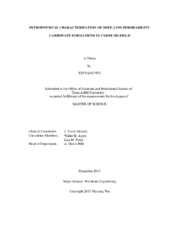| dc.description.abstract | The paper presents a petrophysical modeling and permeability analysis approach for a tight carbonate formation. The formation samples used in this study are from the Tarim oil field Yingshan formation, deposited during Ordovician in the Tarim basin of Southern Xinjiang in Northwest China. The petrophysical modeling is based on a detailed pore structure analysis utilizing thin sections, focused ion-beam SEM images, XRD, and nitrogen and helium porosimetry data. A permeability analysis was performed after the pore structure was characterized. Rock samples from three wells are analyzed. Lab experiments indicate that the samples are rich in carbonate (typically more than 90%) and experienced diagenesis characterized by cementation associated with dolomitization and healed natural fractures. No significant pore volume is observed in thin section images. Nonetheless, SEM images and nitrogen porosimetry both show that matrix pore volume consists of micro-, meso- and macro-pores. Porosimetry data indicate that most of the rock samples are rich in meso- and macropores with an effective pore size of 60-90 nanometers; 34-80% of total matrix pore volume is due to these pores, while the rest of the pore volume is due to natural fractures and larger pores that have not been captured by nitrogen porosimetry. The petrophysical analysis suggests that reliable reservoir storage and flow models to predict the well performances in the field need to be triple porosity, including re-opened fractures imbedded within a matrix that includes meso and macropores. This thesis is a preparation for the next phase of “Petrophysical Characterization of Deep Low Permeability Carbonate Formations for Fluid Storage and Transport Predictions in Tarim Oilfield” which will include a brief description of a single well numerical model with hydraulic fracture to simulate the base-case production trends from the region and compare with the wells’ performances. | en |


